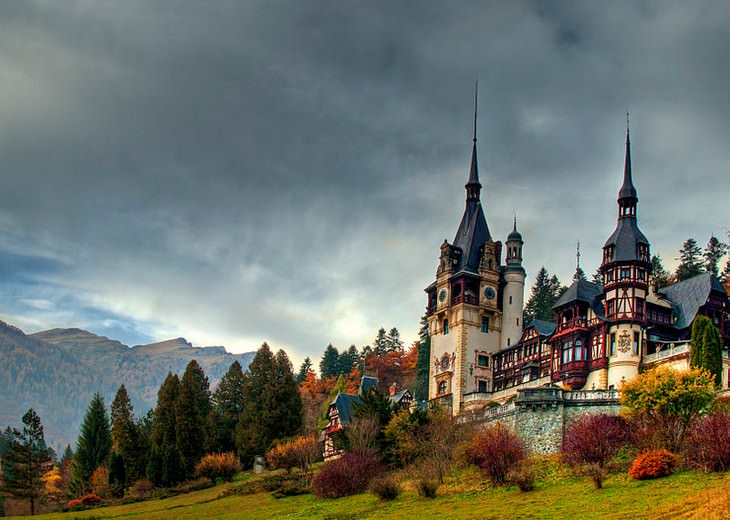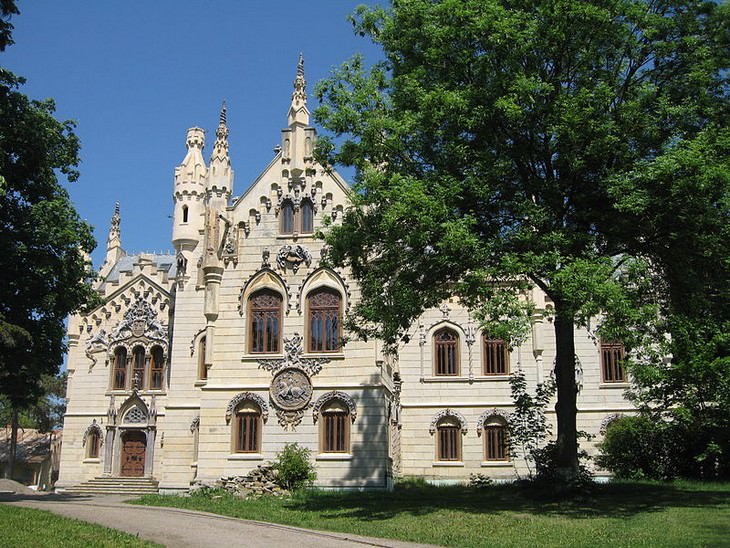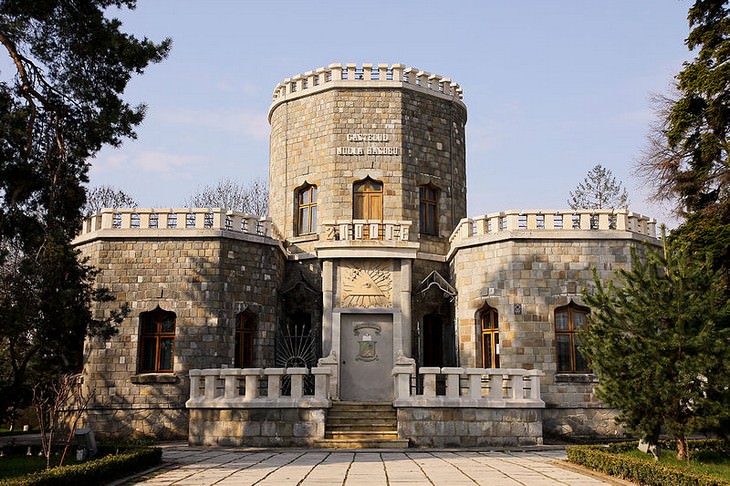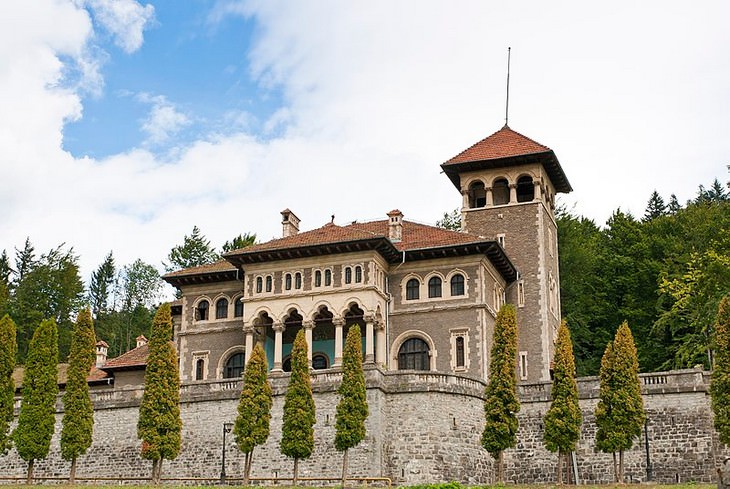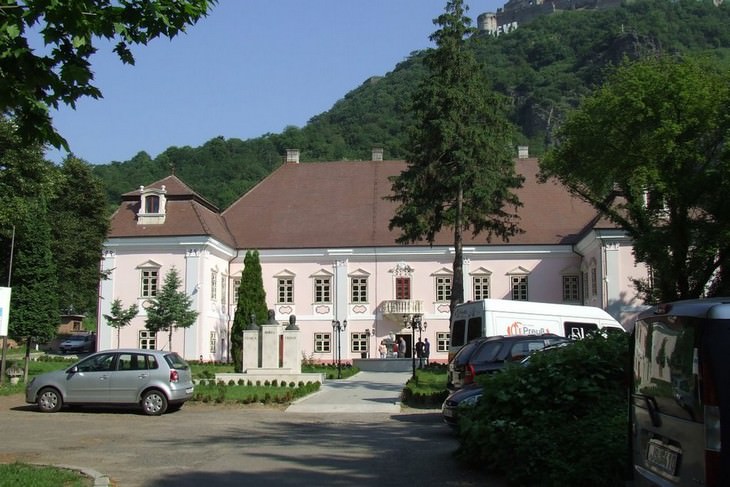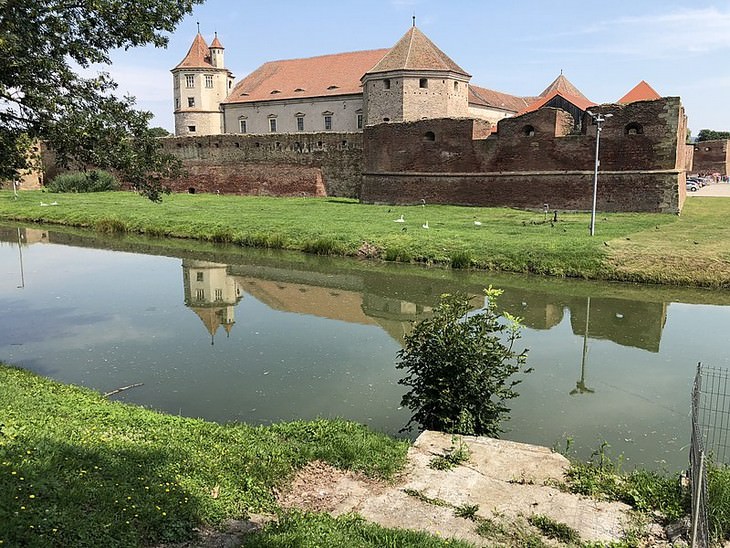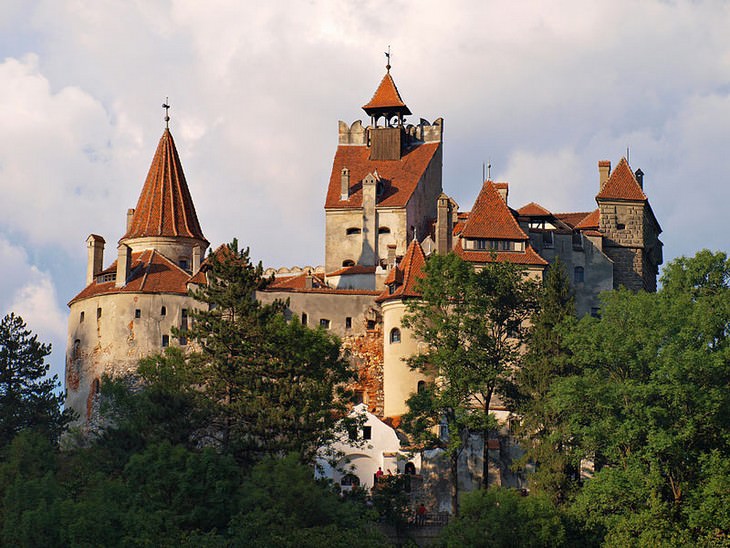1. Fleche Palace
In the photograph, you can see the exquisite structure with its sharp turrets, situated on one of the highest peaks of the Carpathian Mountains in Sinaia, Romania. It is considered to be one of the most striking palaces in the country. The palace was constructed between the mid-19th century and 1914 and was intended to serve as the summer residence of the Romanian royal family under the rule of King Carol I. The palace comprises approximately 160 rooms, with the central tower reaching a height of around 66 meters, flanked by two additional towers named "Filishor" and "Poyshor." The palace also boasts a local power station, making it the first palace in Europe to be electrically connected at that time.
2. Sturdza Castle
The Sturdza Castle, situated in a quiet village on the outskirts of Iasi, is renowned for its charming appearance. It is considered to be one of the most romantic buildings in Romania. The castle is an amalgamation of Neo-Gothic and Baroque architecture that gives it a captivating look. The Sturdza family, a prominent and respected family in Romania, reconstructed and renovated the castle, and many cultural figures and high-ranking leaders were born into this family. The estate comprises a stunning lake, a verdant park filled with ancient trees, and a church. The Strudza family inscribed the words, "Beauty is everywhere," on the front of the building.
3. Iulia Hasdeu Castle
The castle seen in the image has a poignant story behind it, involving a father named Bogdan Patriciiko Hashdau who was a notable figure in Romania during the 19th century. His daughter, Iulia, was gifted and became the first Romanian woman to attend the esteemed Sorbonne University in Paris. Tragically, Iulia passed away from tuberculosis at the age of 19, leaving her father devastated. In her memory, he constructed the castle as a tribute to her, dedicating a room spiritually so that her soul could communicate with him. The castle's serene surroundings add to its magical atmosphere.
4. Banff Castle
Banff Castle, once known as the "Versailles Palace of Transylvania," was a grand edifice featuring a blend of architectural styles ranging from Renaissance to Neo-Gothic, with Baroque being the most prominent. Originally built on the foundation of a simple 15th-century house, the castle underwent numerous transformations throughout the 20th century. During World War II, it functioned as a field hospital for the wounded of the Allies, only to be destroyed by German forces as an act of revenge. Under communist rule, the castle served as a driving school, farm, and even a children's hospital. It was included on the list of 100 sites at risk in 1999.
5. Cantacuzino Castle
The Cantacuzino Castle was constructed in 1911 in an original Romanian style of architecture. It was owned by the Cantacuzino family until it was taken over by the government in 1948. During the communist era, the original furniture was removed, and many parts of the interior were painted and designed according to the spirit of communism. After the fall of communism in 1989, the Cantacuzino family regained ownership of the property, but they sold it in 2004. Currently, the castle serves as a museum that showcases weaponry and portraits of the family.
6. Bethlen Castle
Situated in the Romanian city of Deva, the castle was constructed in the 16th century. Despite being destroyed and rebuilt several times over the years, the building retained its original and distinctive appearance. Similar to Bunfi Castle, this building was also built on the foundations of a smaller house. This house was extensively modified in 1621 by the king of Transylvania, Gabriel Bethlen, who gave it a Renaissance style. However, the building underwent further changes and its architectural design became more closely associated with the Baroque period. Presently, the castle serves as a museum that showcases the history of Deva city, including the various castles in the area and significant archeological discoveries from the region.
7. Fagaras Fortress
In 1310, the Fagaras fortress was established on the remains of an old wooden and earthen fortress. It was built to safeguard Transylvania as an independent entity against foreign invaders such as the Tatars and the Ottomans. The castle underwent several upgrades in 1526, including the thickening of its walls and fortifications to provide better protection against external military threats. However, the Ottomans occupied the castle in 1541, capturing Mihai the Brave, Prince of Transylvania. The fortress was recaptured in 1555 and gifted to Mihai's wife. During the communist regime, it served as a prison for the regime's prisoners, while today it functions as a library and museum, like many other castles in Romania.
8. Bran Castle
One of the most notable castles in Romania is Bran Castle, which was constructed in 1382 by the Transylvanian Saxons with permission from King Melius I of Hungary. The castle was funded by the kingdom and is often referred to by tourists as "Dracula's Castle" due to its mention in Bram Stoker's novel "Dracula," where it serves as the residence of the protagonist Count Dracula, a half-human, half-vampire who originated from the forests of Transylvania and spread his curse throughout England.
9. Rasnov Fortress
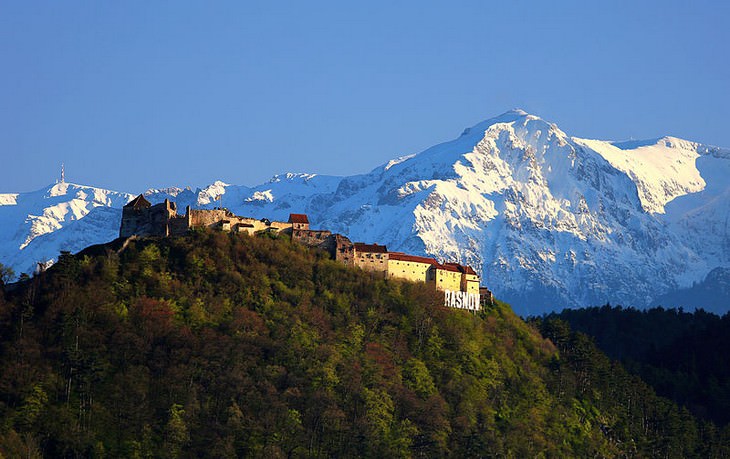
The Rasnov fortress, situated on a high mountain in Romania, serves the same purpose as the Fagaras fortress: to offer extra defense against Tatar and Ottoman invasions into Transylvania. Although the Rasnov fortress has faced damage on a few occasions, including a fire in 1718 and an earthquake in 1802, it has been restored to its original condition during the communist regime between 1955-1966.
In 1612, during the reign of Gabor Bathory ("the Mad King"), the fortress was captured for the only time in its entire history - the main reason for its fall was the blocking of the only water source of the place by Ottoman forces. During the siege imposed by the Ottomans on the place, its inhabitants forced two Ottoman prisoners to dig a water well to a depth of about 146 meters for 17 years to provide the castle with a proper water source. Today, visitors can observe inscriptions from the Koran engraved on the inner sides of the well. The fate of the two prisoners who dug the well remains a mystery to this day. There are conflicting opinions - there are those who say they were released and those who claim they were murdered. Regarding the well itself, local elders claim that at the bottom of it, there is a 300-year-old treasure.

